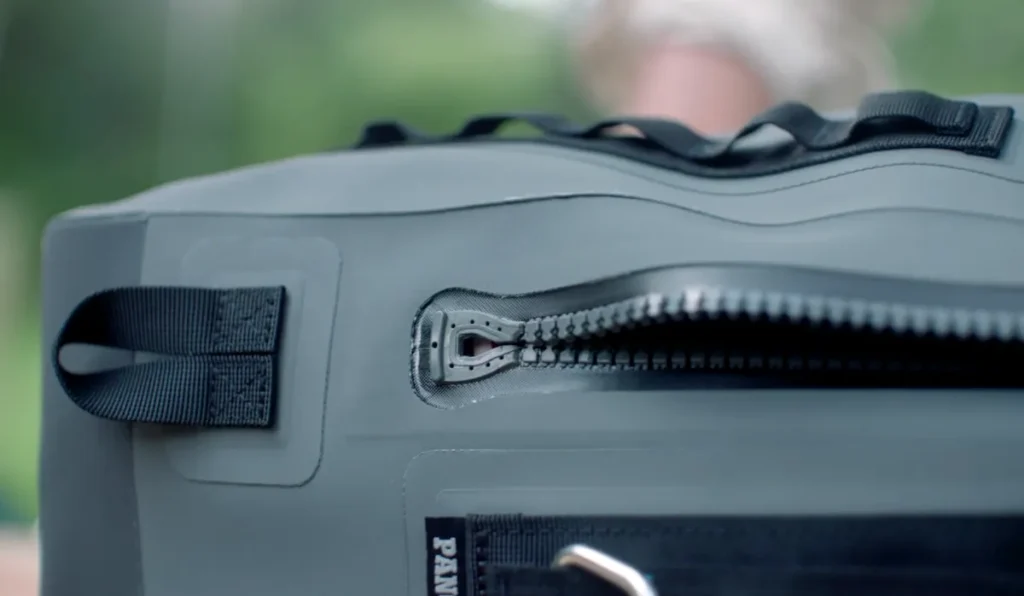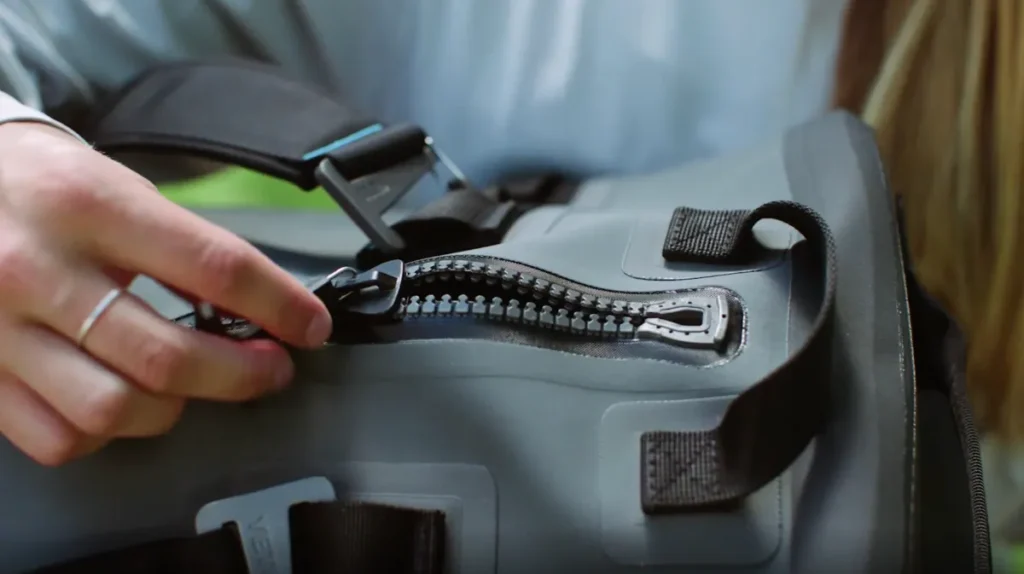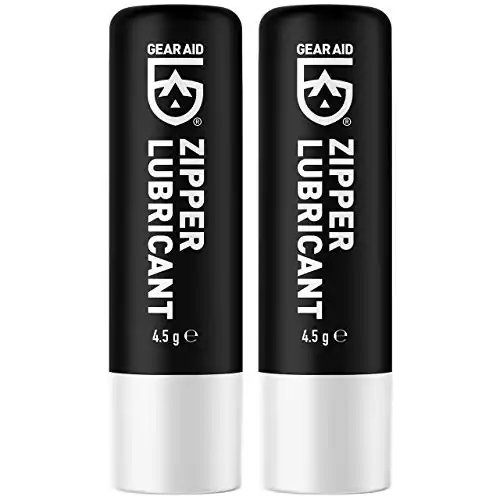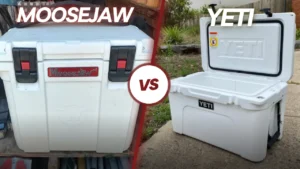Yeti coolers are a serious investment (for a good reason), so it’s natural to want them to last. When purchasing a product like the Yeti Hopper, one of the most common problems you’ll face is the zipper locking up and eventually breaking.
A great way to avoid this from happening is by regularly apply zipper lubricant to the zipper. But how exactly are you meant to do this?
Yeti doesn't give great instructions on how to do this so how exactly should it be done?
To apply Yeti zipper lubricant rub stick lubricant onto the zipper teeth sparingly and run the zipper back and forth over it a few times. For liquid lubricant apply the lubricant directly to the zipper slider and move it back and forth a few times.
If lubricant isn't applied to the Yeti zipper on a regular basis it can get extremely stiff to open and close and this can lead to the zipper completely breaking if you aren't careful.
If you regularly lubricate your zipper there is a much smaller chance of the zipper breaking and you'll notice a huge difference in how easily the zipper opens and closes.
Yeti provide you with one free stick of lubricant but how exactly do you apply this to the zipper?
Yeti's Instructions Are Somewhat Vague
Yeti does provide instructions on how to lubricate the zipper but they are quite vague. Here's some information from their Hopper FAQ page.
Make sure you apply this lubricant following cleaning, before storage, and anytime the zipper feels stiff. Make sure your zipper is always free of dirt, grime, or other debris for maximum performance and life.
This is the same as the information from the Hopper user manual.
We recommend long-term storage with the zipper in the fully closed position to help protect the U-Dock™ seal. We also recommend regular application of the included zipper lubricant — especially when putting into storage — by carefully applying the lube to the U-Dock front, back, and inside.
People Tend To Use 2 Main Methods To Lubricate Their Yeti Zipper
While Yeti seems to say to apply the lube to the U-Dock Yeti users seem to be mixed on exactly how they apply lubricant to their Yeti zipper.
Here are the most common methods:
1. Rub Hard Stick Lubricant Over All The Teeth Of Your Zipper
This is the method I personally use to lubricate the zipper of my soft sized cooler.
Open the cooler up and gently rub the lubricant stick over the entirety of the zipper, top and bottom – getting lubricant on all the teeth of the zipper.
I don't push hard with the lubricant but I just rub it lightly over the zipper.
Then open and close the zipper a few times so the slider can get effectively lubricated too.
The benefit of this is that the entire zipper is lubricated and should be fairly easy to open and close the whole thing. The downside of this is that you can use too much lubricant (which can be wasteful) or the extra lubricant can attract sand and dirt which can clog the zipper.
Here's what rifle_shot says on Reddit about this very technique:
I lube the whole zipper but don't use alot – just a very quick skim along the teeth. Then I run the zipper back and forth a couple times to work it in. Never had a zipper break on any Yeti or knockoff cooler in 7 years. (now that I said that I expect to break one in the next 48 hours).
2. Lube The U-Dock Only

The other method is to run the zipper lubricant over the U-Dock on the top, bottom, outside and inside.
The U-Dock is a fancy name for the end of the zipper. It's the spot the zipper slider sits in when it is full closed.
Once lubricated, close the zipper into the U-Dock so the slider comes into contact with the lubricant. Open and close the zipper a few times to spread the lubricant through the entire slider.
RocMarc says this on Reddit:
I follow the rules on the site and only lube the dock
The benefit of this method is it uses less lubricant and dirt and sand is less likely to get stuck in the teeth.
The downside of this method is that when your zipper is particularly tough and stuck this may not be enough to lubricate it and it could still lead to breakages.
Make Sure You Get a Compatible Zipper Lubricant
Yeti gives you a stick of lubricant when you purchase a soft sided cooler or a Panga backpack or duffel. This works great but you can also purchase other brands of zipper lubricant too.
There isn't anything super special about the Yeti zipper lubricant. Any zipper lubricant will do the job.
Carefully select and purchase a zipper lubricant that’s designed for use on metal and plastic zipper components. Most Yeti zippers are designed with hard plastic teeth, and metal pulls, so the lubricant must be usable on both types of materials.
If you choose a lubricant stick, you’ll apply it to all the teeth of the zipper; if you choose a liquid, you’ll apply it to only the slide. Once you have the lubricant, you’re ready to start the process of maintaining your Yeti zipper.
I personally like the Gear Aid Zipper Lubricant Wax Sticks (at Amazon) as they are super affordable and work great. But honestly, any brand will likely do the job just as well.
This zipper lubricant wax is non-toxic and silicone-free formula that lubricates and protects nylon, plastic and metal zippers against sand, salt, chlorine, rust and corrosion for years of smooth zipping.
Great for soft coolers, wetsuits, backpacks and tents.
Carefully Clean Your Zipper When It's Dirty
I don't personally put a lot of focusing into cleaning my Yeti zipper regularly but if I've been to the beach or it's gotten a lot of dirt inside the zipper then it will need a good clean (and dry) in order to avoid breaking the zipper.
But I do rinse the cooler after each use (zipper included) to keep it free from dirt and grime.
Rifle_shot on Reddit warns about the dangers of this:
be very careful with sand on the beach – that is one of the most common ways to break the zipper (it get's stuck between the teeth and causes them to jam and get broken. It shouldn't be an issue as long as you always make sure to rinse off your cooler when you get home, especially the teeth, to clear out any sand that might get stuck.
Before lubricating your Yeti zipper, clean it fully to remove any built-up dirt.
This helps ensure you don’t make the grime stick worse by combining it with your lubricant.
Create a solution made from a small squirt of dish soap in hot water. Filtered or stilled water will help you achieve the best results.
Dip a clean toothbrush into the soapy water and gently brush each of the teeth of your Yeti zipper to work out any dirt and to remove grease buildup.
Take your time and scrub every tooth completely. Rinse off each of the teeth and the slide to wash away the soap, water, and grime.
After cleaning the zipper, leave the cooler to air dry for several hours until it’s no longer damp. You want it to be COMPLETELY DRY before adding the lubricant.
This will help the lubricant adhere to its surface effectively. You can place it in front of a fan to speed up the process.
Once the zipper is dry, you’re ready to apply your lubricant of choice.
Make Sure To Work the Lubricant In Fully

After you've lubricated the zipper make sure to move the slider back and forth across all the teeth of the Yeti’s zipper to work in the lubricant.
If you notice one section of teeth is more difficult to slide over, apply more lubricant to that section specifically.
Continue working in lubricant and applying more as needed until the zipper operates smoothly on all sections.
Maintain Proper Lubrication Over Time
Lubricating your zipper is not a one-and-done deal. You need to attend to your zipper regularly.
To keep your zipper operating smoothly, repeat this process once every few months throughout the year or whenever your zipper begins to feel stiff and difficult to move.
The zipper should always slide freely, and if it starts becoming more difficult, you can repeat this treatment to avoid damaging your cooler.
As I always say “you can never use too much lube”.
But seriously it's better to over-lubricate your zipper than to under lubricate it.
Yeti coolers aren’t cheap, but they are worth the investment when cared for well. Learn what benefits you’ll enjoy from your Yeti cooler, and take great care of your cooler to maximize those benefits over time.
Care for Your Zipper for Long-Term Reliability
Effectively lubricating the zipper on your Yeti cooler is just one part of effectively maintaining your zipper over time. It’s important to use the zipper with care and to clean it properly over time to ensure it has a long lifespan.
Be careful to avoid overfilling your cooler each time you use it. The zipper should always slide freely, and if you struggle to zip up the cooler because the sides are bulging out, you’ve added too much. Remove some of the items to avoid damaging your zipper.
Try and use gentle pressure when opening and closing the zipper on your Yeti. If you notice the zipper feels stuck, move it in the opposite direction that you’re trying to go and look for any snags or debris. Avoid pulling the zipper hard, or you could damage it.
Finally, regularly wash and lubricate your zipper to keep it operating smoothly for many years. If you follow all these care instructions, you can count on your zipper to work well for many years.
If your zipper does happen to break Yeti will often replace a broken zipper with a new cooler if it's under warranty so get it contact with them if your zipper does break.
Follow these care instructions and make yourself aware of the other Yeti soft-sided cooler issues outlined here, and you’ll be a more effective cooler owner.
Where Do You Buy More Yeti Zipper Lubricant
There is nothing crazy special and unique about the Yeti Zipper lubricant.
If you lose your Yeti zipper lubricant or run out then you can purchase any brand of zipper lubricant out there. Unfortunately Yeti does NOT sell zipper lubricant separately, they only provide one stick free with your cooler.
I personally like and recommend the Gear Air Zipper Lubricant Wax Sticks (at Amazon) as they are super affordable, from a trusted brand and work great with the big, tough Yeti zippers.
This zipper lubricant wax is non-toxic and silicone-free formula that lubricates and protects nylon, plastic and metal zippers against sand, salt, chlorine, rust and corrosion for years of smooth zipping.
Great for soft coolers, wetsuits, backpacks and tents.
You may also be able to get some free Yeti zipper lubricant directly from Yeti. Snobius reported on this Reddit thread:
I've seen other people report that if you email yeti about trying to purchase more zipper lubricant, they will send you some for free.
Don't Use Yeti Zipper Lubricant For Your Lips
It seems a bunch of people (young and old) have received a Yeti cooler only to think that Yeti provided them with a complimentary chap stick for their lips.
While Yeti cooler lubricant is unlikely to harm you if you put it on your lips it's much harder than regular chap sticks and definitely designed for the cooler zipper teeth, not your mouth.
@kljlbutton She gets a free gift from #YETI and was so excited she didn’t bother to read the label 🤦♀️ #zipperlubricant #Yeti #adventuresofKl ♬ original sound – user1015115106622
Summary
Once you understand how to properly lubricate your Yeti zipper, you’ll enjoy a smoother operating cooler that will hold up for far longer.
Most zipper issues can be easily avoided with careful use, preserving your investment for far longer.







